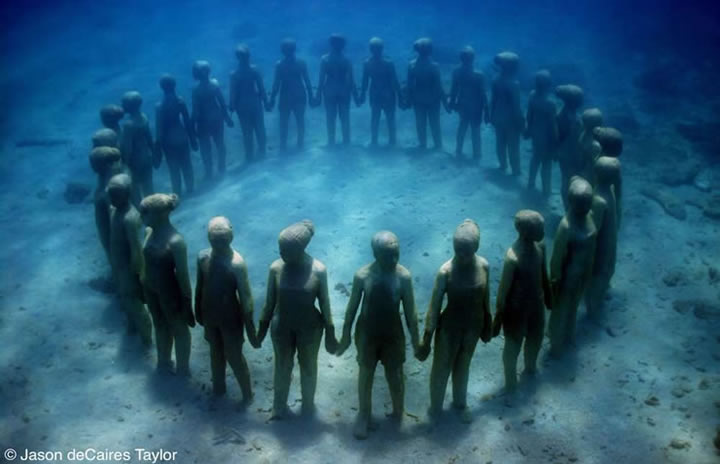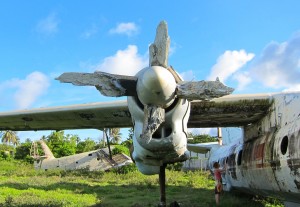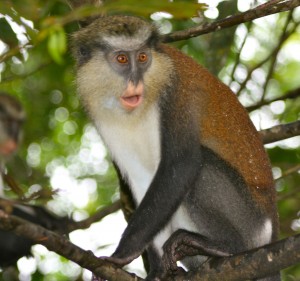The oft-overlooked island of Grenada has everything that winter-weary Canadians might want from a sun vacation, but with a few spectacular bonuses

This story first appeared in the Toronto Star travel section on October 20, 2012
By Stephen Wickens
Aside from the cows and egrets, Pearls Airport sits deserted.
It’s not in Grenada’s guidebooks and not listed on today’s itinerary. But it’s a highlight nonetheless and everyone on the bus wants off to see the Cuban planes, abandoned to scavengers and the elements since the 1983 U.S.-led invasion.
“It should be a national monument,” says Mandoo Seales, a passionate guide who prefers “rescue” to “invasion” when speaking of Operation Urgent Fury, a Reagan Doctrine strike that snuffed a 4½-year experiment with revolutionary Marxism.
“It’s an archeological site. We shouldn’t let it deteriorate further.”
Ex-U.S. soldiers prompted Seales’ first tours to this 1940s-vintage airport, shut since 1984. “I bring lots of people here now,” he says. “All kinds are fascinated.”

It’s funny how the accidental tourist attractions are often the best. And Grenada has others, including the Underwater Sculpture Park and Levera Beach leatherback turtle sanctuary.
British sculptor/diver Jason de Caires Taylor originally pitched the underwater park to Grenadians as art that might help restore coral reefs. It succeeded on both counts, with new growth gradually completing the statuary. Now Taylor’s creation is on National Geographic’s list of “Earth’s 25 Most Awesome Places” and Mexican officials have commissioned him to produce a larger version in Cancun.
I’ll be back at this underwater park, though next time, instead of snorkeling, I’ll have scuba certification and a serious underwater camera.
The leatherback project, meanwhile, was hatched to help save a remarkable species from extinction, even if it meant disruption for locals who had relied on meat and eggs from Earth’s largest sea turtles.
“We now earn revenue from people coming to see this (April to August),” says Kimron Redhead, a supervisor on the project, launched in 1999. “There are definitely more turtles again,” he says. “You can only sell a turtle or her eggs once, but tourists come back again and again.”
And it turns out that the resurgent turtle population has helped the local tuna fishery because leatherbacks feed on jellyfish who had been decimating schools of baby tuna.
Trying to snap photos of the egg-laying can be problematic as leatherbacks work at night and flash photography has to be banned because it would interrupt the mood for mama turtles. But usable photos or not, the awe seemed unanimous the night I visited.

“I must have shot 100 pictures and they’ll all be rubbish,” Ben Carroll of London, England, says, echoing others among us.
“But it hardly matters. The hair on my neck was standing. Seeing how hard she worked to dig a hole, lay the eggs and cover them. That last turtle must have been six feet. Getting to stroke the shell, that’s powerful.”
If you want casinos and nightlife, Grenada’s not for you. But it offers most of what winter-weary Canadians want from sun vacations – with several bonuses. It’s also easily reached from Toronto since Caribbean Airlines launched year-round non-stop service.
Despite being a volcanic island, it has white-sand beaches, including Grand Anse, a regular on Caribbean best-of lists. Because Grenada has just 1,200 hotel rooms, beaches aren’t crowded, even in high season.
It’s a generally affordable island, though, like the expensive ones, crime rates are low and litter is scarce. Once you’ve seen the bountiful gardens, you’ll know why Grenada’s worst finish in 13 years at England’s famed Chelsea Flower Show has been silver.
“It’s like a lusher, much-less-developed Barbados,” says Carroll, who also raved about rainforest hiking in the island’s interior.
Grenadian cuisine is interesting, too, no surprise for “the spice island.” Nutmeg is the big export (though still down 50 per cent since tree damage from 2004’s Hurricane Ivan), but there are constant mealtime reminders of the endless list of spices and fruits that grow here.
Like most Caribbean islands, there are colonial forts for history buffs, but Grenada’s have seen recent combat – battles people still calmly debate, even as the Cuban planes rot.

Locals seem to see both sides of their place in Cold War history. There’s no clamour to revive socialism, but under the current prime minister – who spent two years as a political prisoner when Communists ruled – the airport was renamed for Maurice Bishop, who led the 1979 revolution.
You’ll hear tales of corruption and brutal autocracy under Bishop, sometimes from the same people who credit him for steep rises in literacy rates and the creation of real healthcare. There’s still graffiti thanking the Americans, though some locals seem convinced the chaos and bloodshed used to justify sending in troops was initiated by a Central Intelligence Agency-driven destabilization campaign, ostensibly led by Bishop’s deputy.
And no matter how real the fears were in the Reagan White House, we’ll never know for sure if the Soviet Empire ever planned to attack the Americas from that Cuban-built runway beside the Maurice Bishop terminal building. But with the Cold War mostly just historical curiosity, we do know the landing strip is plenty long enough for jet-loads of tourists.
JUST THE FACTS
ARRIVING: Caribbean Airlines flies non-stop from Toronto on Thursdays and Saturdays year-round. Air Canada Vacations has seasonal non-stops and Sunwing operates charters.
SLEEPING: The Blue Horizons is excellent if you don’t mind a 300-metre walk to the beach. Mount Cinnamon and Spice Island are great spots right on Grand Anse beach. LaSource will soon reopen as a Sandals Resort.
DINING: Even if you don’t stay at Blue Horizons, visit the resort’s La Belle Creole restaurant. The menu changes daily, but it’s outstanding. Other recommendations are BB’s Crabback (bbscrabback.co.uk), The Aquarium (aquarium-grenada.com) and Dodgy Dock (truebluebay.com/resort-facilities/details/dodgy-dock-restaurant).
DOING: The rainforest hike to the interior waterfalls is big fun, but expect to get muddy (grenadatours.com/hikes.htm). Also worthwhile are tours of the organic chocolate operation (grenadachocolate.com) and the old water-wheel-driven River Antoine rum distillery, though be careful with the high-test fire-water (grenadaexplorer.com/tip/rumfactory).